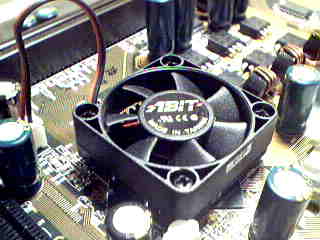ABIT KT7A-RAID Socket-A KT133A ATX
by Mike Andrawes on January 21, 2001 11:31 PM EST- Posted in
- Motherboards
The Features: 133MHz is finally here!
The new VIA 8363A North Bridge sits close to the CPU socket, covered by ABIT’s unique HSF unit. The 8363A is the core of the KT133A chipset that provides all the major features of the board including the 133MHz FSB, 100 / 133MHz memory bus, as well as AGP 4X support. The AGP Slot is a "universal slot," which means it is not keyed specifically for AGP 2X or AGP 4X cards, so you can install almost any current AGP card in the slot.

In the past, the KT133 chipset had been disappointing in terms of FSB overclocking. Even though most motherboards provide a wide range of FSB speeds, none can make any use of the FSB frequencies greater than 115MHz in most cases. That not only limited the use of any 133MHz FSB Athlons, it also seriously limited the overclocking potential of the motherboard as well. The limitation was partially present in the VIA North Bridge itself and also due to the KT133 designs that were available at the time as well.
Now the 8363A North Bridge officially supports the 133MHz FSB (266MHz DDR), thus offering support for the new 133MHz FSB Athlons as well. In the past, even with 1GHz Athlons, users are limited to a FSB speed of 100MHz and a multiplier of 10, meaning that the CPU is running 10 times faster than the FSB frequency. Now the KT133A chipset allows users to have FSB speeds of 133MHz and possibly higher, so that with the same 1GHz chip, users can lower the multiplier to 7.5, and effectively boosting the overall performance while remaining at the same clock speed. Most of the recent AMD Socket-A motherboards have included the hardware mechanism for changing the multiplier ratio settings of AMD processors, so this can be done easily. There is some effort required on the user’s part to prepare their CPUs for overclocking, however we have diagrammed exactly what is necessary in our Athlon Overclocking Guide.
The three DIMM slots on the KT7A-RAID can support up to a maximum of 1.5GB SDRAM. Like the old VIA 8363 North Bridge the 8363A is replacing, it allows users to run their memory at either 100MHz or 133MHz. This feature was welcomed by a lot of users since you could use your old PC100 SDRAM with your new motherboard, saving you the cost of upgrading. And for those that wanted the added bandwidth of PC133 SDRAM the chipset offered that option as well.
However, with 133MHz FSB support the situation is changed slightly. If you decide to run your CPU at the 133MHz FSB be sure to you have some PC133 memory ready because the chipset will only allow you to run your memory synchronously with the FSB if you set the frequency to 133MHz or higher. Officially the KT133 chipset only supports FSB - Memory ratios of 100 - 100, 100 - 133, or 133 - 133. With the KT7A-RAID, things are a little bit different . We will address that later as well.
Since motherboard manufacturers have to modify their designs to make way for the KT133A North Bridge, there is nothing keeping them from including a new South Bridge as well; in this case, the VIA 686B is the perfect candidate for replacing the 686A. They both have a second USB controller hub and an integrated PCI to ISA bridge. The advantage of the 686B over 686A is that it supports Ultra ATA 100, whereas the 686A only supports Ultra ATA 66. The Ultra ATA 100 controller provides two IDE channels that support up to 4 IDE devices (two per channel).
Two traditional USB ports are mounted at the back of the motherboard together with the serial / parallel ports, and there are connectors ready for a third and fourth USB port the front of the board. Just like other ABIT motherboards, ABIT includes the USB header to take advantage of the second USB controller hub.
From the expansion slot perspective, the KT7A-RAID is absolutely brilliant. The 6/1/0/1 (PCI/AGP/AMR/ISA) expansion slot design provides an almost perfect combination for all the hardware enthusiasts out there. We enthusiastically applaud ABIT’s decision to kill the AMR slot, which we haven’t seen any use for at all. Instead of implementing an AMR slot ABIT decided to take advantage of the PCI-ISA bridge of the 686B South Bridge, and provide an extra ISA slot for users with an old ISA modem or SCSI controller card.
Furthermore, ABIT did not outfit the KT7A-RAID with any from of integrated audio. This can reduce the cost of the board since most users would prefer to use a hardware based PCI audio solution, however this decision may hurt some OEMs and system integrators that would like to take advantage of a cheap integrated audio solution. Unlike AMR slots, we have actually seen OEMs and system integrators take advantage of an integrated audio solution.










2 Comments
View All Comments
BobbieJohnson - Thursday, February 20, 2020 - link
Best quality hardware is very important in the field of electronics. This is the thing that makes your projects successful and now https://awriter.org/kingessays-com-review/ help students to manage the task. This Anandtech Company is giving you the best electronics equipments at very best rate. These products are good in quality.jselleck893 - Wednesday, September 15, 2021 - link
Awesome company, I think Anandtech is the amazing company that I ever encounter. <a href="https://www.iowacityconcretecontractors.com"&...